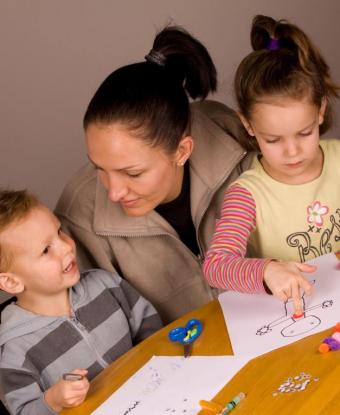9 Positive Parenting Techniques

If you've ever felt that your home has dissolved into a whining, screaming, nagging mess, you could benefit from some positive parenting techniques. As the name suggests, "positive parenting" focuses on the positive rather than the negative, choosing positive reinforcement, natural consequences, and conversation over spanking, grounding, and screaming.
While positivity sounds good to most people, it can be difficult to understand how to put it into practice on a daily basis. These techniques will help.
Play With Your Kids Everyday

Most parents play with babies, but many start to lose that sense of fun as their children get older. With our hectic schedules of work, school, and chores, it's easy to lose sight of things like play.
It's important to realize that carefree fun is essential. It helps the entire family to relax, creating a more loving, open environment. Some of the best communication opportunities arise during downtime. Play doesn't have to be structured. It doesn't have to be an all day affair. Bonding happens in the little, spontaneous moments too. Be playful while you're doing dishes. Make your car trips more fun.
Touch Your Kids

Never let a day pass without hugging your kids. Hugs make both giver and receiver feel good. They make parents feel calmer and kids feel more secure, so don't reserve hugs for bedtime.
Kids, like adults, have different thresholds for physical touch. If your kids are uncomfortable with too much contact, don't push the issue. Start small, with pats on the back, touching their elbows as you speak, and a hand on the shoulder. As your child becomes more comfortable, you can progress to hugs, cheek kissing, and holding hands.
Truly Listen to Your Kids

Too many parent-child conversations involve the parent telling the child what to do. Try to engage in actual conversation instead. Get your child talking, and actually listen. Do not judge, do not interrupt. Put away your phone and your computer; turn off the television.
If you and your child are new to the concept of open conversations, try these questions to get the ball rolling:
- What do you want to be when you grow up?
- What makes you happiest?
- What is your favorite memory?
- What makes you proud?
Positive Parent Technique: Jobs

Kids should not be treated like guests-- or burdens-- in their own home. They should be made to feel like part of the family.
You can accomplish this by making your home a team effort. Get every member, from the youngest to the oldest, a job. A family chore chart is one of the easiest ways to start. Toddlers can pick up toys. Preschoolers can sort socks. As kids get older, increase their responsibility around the house.
Make Your Home a No Hitting Zone

Spanking is the go-to discipline tactic for many families. While opinions vary on whether or not spanking is abusive, there's one thing we can all agree on: it is not a form of positive parenting.
Positive parenting techniques aim to remove intimidation, threats, and pain from the parenting arsenal. Make a decision that you will not spank. This does not mean you will give up on discipline, simply that you'll find more positive methods.
If you feel tempted to spank, give yourself a time out. Calm down. Take deep breaths. Take a bubble bath if you enjoy them. After you're feeling calmer, you'll be better equipped to deal with the situation.
Set Them Up for Success

Certain situations try anyone's patience. Set your child up for success by making sure that he is well rested, fed, and healthy before putting him in situations or environments that ordinarily cause a meltdown.
If your child is prone to tantrums in waiting rooms, for example, bring him books, small toys,and other activities to keep him occupied. Try to keep him quietly stimulated to avoid problems. Never make appointments at meal or sleep times.
Catch Her Doing Something Good

As parents, we're pretty attuned to our kids' missteps and misbehavior. We say "no" all day long. It's not surprising that kids start to tune out their parents after a while.
To create a more positive atmosphere in your home, start catching your kids in the act of doing good. When you see your kids being kind, helpful, or compassionate, point it out. A smile, praise, pat on the back, or actual reward can go a long way towards giving your kids the incentive to keep behaving well.
Sign up for our newsletter featuring all the latest stories and products we love.
Self Care Is Key

Some parents become martyrs, sacrificing their own needs for their kids. This is actually a terrible strategy! A tired, sick, resentful parent isn't good for anyone.
Instead, take the opposite approach: focus on your own needs. Indulge in a hobby, make time for yourself everyday, and cultivate your own friendships. When you feel solid and strong as a person, you'll naturally be more effective as a parent.
Keep Learning

A family is an ever-evolving work in progress. Never stop learning how to be a better parent.
For more ideas, read:
- Attachment Parenting
- Parenting Styles
- Essentials of a Good Parent







